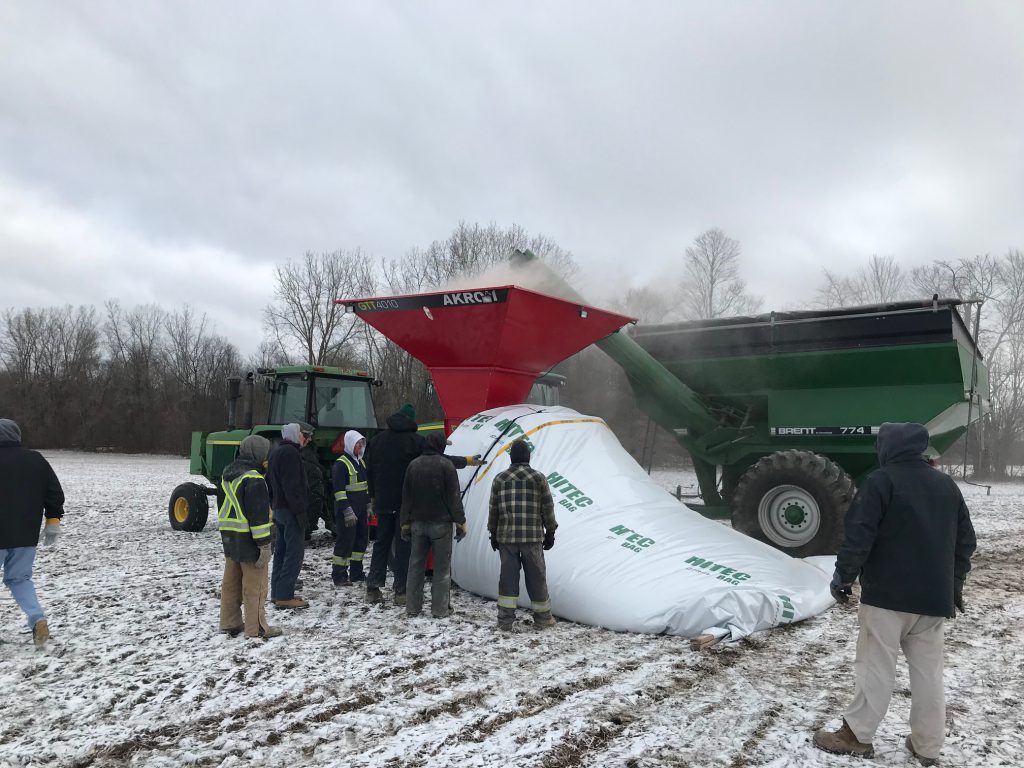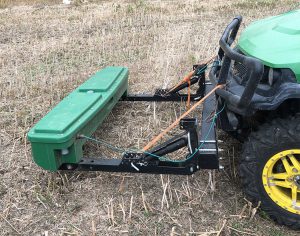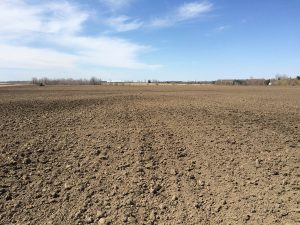Storage flexibility in DON-infected corn
GRAIN BAGS OFFER GOOD ALTERNATIVE TO IMMEDIATE SHIPPING

GRAIN BAGS OFFER Ontario farmers another way of reliably storing vomitoxin-infected corn, according to a recently concluded Grain Farmers of Ontario-funded study.
Participants in the research project say bag storage is a flexible, practical alternative to trying to ship and sell high DON corn during and shortly after harvest. Despite some challenges, it is a solution they would willing use again.
PROJECT OVERVIEW
The project determined the effectiveness of grain bags at maintaining corn quality over an extended period, as well as the practicality of actually using the storage system on-farm. Several ag-businesses, as well as University of Guelph researchers, participated in the project.
At four different sites between January and July 2019, the carbon dioxide levels, oxygen levels, and temperature of four large grain bags were measured on a weekly basis. Grain moisture, water activity, test weight, and mycotoxin content were measured at the beginning of the monitoring period and when the bags were emptied.
GENERAL RESULTS
As described by Art Schaafsma, the project’s lead researcher, temperature fluctuated in-tune with ambient exterior temperatures, and was thus not a useful metric for gauging quality in bags. Mycotoxin and moisture concentrations were similar for grain sampled at the beginning to those at the end of the period, suggesting that no spoilage occurred and the grain was safely stored. A steady rise in carbon dioxide, along with a steady decline in oxygen, indicated anaerobic conditions were maintained throughout.
The only significant spoilage occurred when the bottom of a bag was perforated by residual crop stubble, allowing water to enter. Overall, however, such spoilage was limited to the perforated areas.
In general, “The only loss in quality was a slight reduction in test weight, but this was typical for normal shrink that occurs during the same period of storage in vertical grain silos,” says Schaafsma in the project’s summary report.
He concludes by saying grain bags are a useful tool to store excess grain in a crisis situation – if the grain is dried before storage, the bags have no perforations, and they are not open before unloading.
ON-FARM EXPERIENCES
Chuck Baresich and his colleagues at Haggerty Creek Ltd. were one of the companies participating in the research project. In their experience, the grain bag system was easy to set-up and operate. Placed on flattened cornstalks in the middle of a field, no spoilage due to residue or wildlife-related perforations occurred during the three-month duration in which the bag was laid.
The loading and reclaiming system was itself efficient and fast. Farmers could reasonably share equipment rather than buying their own units.
“It was incredibly straightforward to set up. There wasn’t a bucketful that the reclaiming system didn’t collect,” says Baresich. “We would do it again. It works in the west, so why not here?”
Managing and disposing of the plastic proved to be the only major challenge at Haggerty Creek.
Baresich says the bags become essentially useless after being emptied, making it necessary to find someone to take the material for another purpose. This was eventually done, though the risk of attracting rodents from plastic with a strong grain smell could limit the number of potential secondary uses (e.g. as a construction material).
Leaving bags for more extended periods of time might also increase the potential for spoilage. At Aylmer’s College Grains Inc., Jay Shackleton says the bottom of some bags became soft and mushy after over nine months in the field, making them more difficult to pick up. Perforations were also an issue, though one potentially resulting, at least partially, from laying the bag on frozen ground. Overall, Shackleton says they are “not totally sold” on the process – at least, not as something to be used every year.
Schaafsma, too, says better site preparation is needed before silo bags are deployed. That means removing all rocks and grain stubble, as well as keeping the area well drained to prevent ponding.
Ensuring the bag itself is level is another factor, as Matt Hollinger of Victoria County Grains discovered.
“The only challenge we really ran into, and it was more neglect than anything, is we put the bags on an angle so all moisture went to one end,” says Hollinger. “The grain didn’t spoil because it was cold outside, but it was super saturated.”
A GOOD BACKUP OPTION
Despite these challenges, however, each participant reiterates bags are, by-and-large, very useful in relieving the pressure – and consequences – of looking for someone to buy corn with elevated vomitoxin levels in-season.
“When you truck it because you have to, everyone is in the pickle at the same time. If the end user and you have problems you end up having to settle with the lowest denominator. If the end user could only get a buck a bushel, that’s all we were going to get,” Baresich says
“We all knew if we could space out the delivery this wouldn’t happen.”
Shackleton and Hollinger express a similar sentiment, adding bags are an excellent shorter-term solution in high-vomitoxin years, despite the difficulties.
“For someone like myself and the farmers that deliver to me, it helped immensely,” says Shackleton.
This project was funded in part through the Canadian Agricultural Partnership (the Partnership), a federal-provincial-territorial initiative. This project was also funded in part by Grain Farmers of Ontario. •
Look for the followup article: Improving DON detection in harvested grain



























